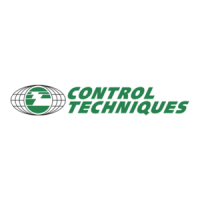
Do you have a question about the Control Techniques M'Ax 406 and is the answer not in the manual?
| Brand | Control Techniques |
|---|---|
| Model | M'Ax 406 |
| Category | Servo Drives |
| Language | English |
Explains drive configuration and control through software parameters in menus.
Instructions for making electrical connections to the drive, including setup without AC supply.
Provides example wiring diagrams for various signal connection applications.
Explains parameter structure, types, read-write status, and menus.
Provides a step-by-step guide for editing parameters using the keypad and display.
Instructions for making electrical power connections, emphasizing safety precautions.
Describes how to restore the drive to its factory default parameter settings.
Explains how to edit parameter values, including momentary key action and scrolling.
Instructions for making electrical power connections, emphasizing safety precautions.
Step-by-step guide for operating the drive using the keypad interface.
Step-by-step guide for operating the drive via serial communications.
Step-by-step flow chart for setting up the drive in version _AN.
Step-by-step flow chart for setting up the drive in version _SL.
Procedure for setting up a custom user security code to protect parameters.
Steps to unlock User Security to allow parameter editing.
Steps to unlock Standard Security to access advanced menus.
How to lock Standard Security and User Security after setup.
Focuses on parameters related to speed-loop PID gains for dynamic performance.
Details parameters and diagrams related to torque control functions.
Covers parameters and diagrams related to motor control functions.
Parameters for status, diagnostics, and trip log information.
Details alarm indications appearing on the drive's lower display line.
Lists and describes various trip codes that can occur, their causes, and numerical values.
Lists parameters for controlling dynamic performance in speed control, focusing on PID gains.
Procedure for adjusting speed-loop PID gains to optimize drive performance.
How to specify shaft stiffness and load inertia to help calculate PID gains.
How to set up and select different PID gain sets for various operating conditions.